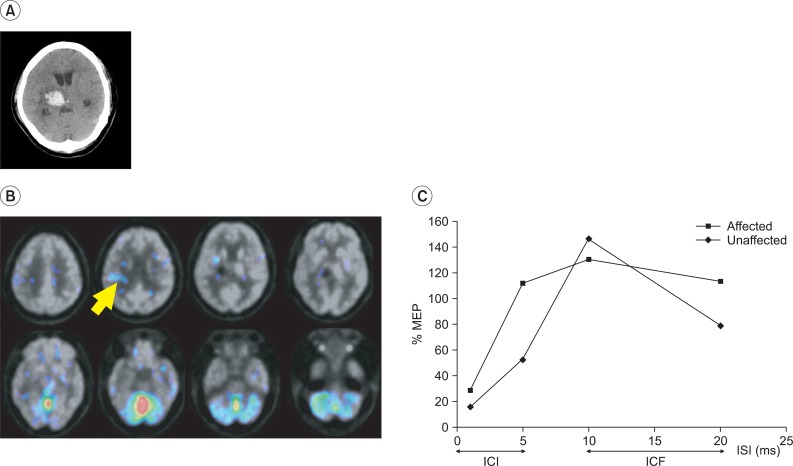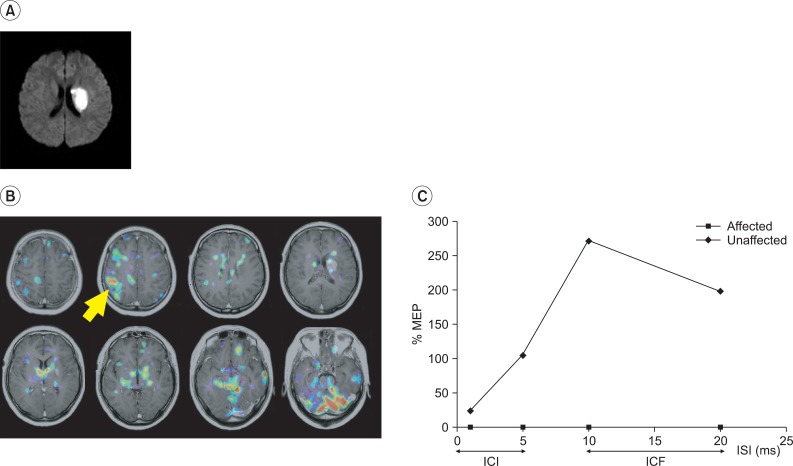Ann Rehabil Med.
2012 Aug;36(4):501-511. 10.5535/arm.2012.36.4.501.
Prediction of Motor Function Recovery after Subcortical Stroke: Case Series of Activation PET and TMS Studies
- Affiliations
-
- 1Department of Rehabilitation Medicine, Seoul Metropolitan Government-Seoul National University Boramae Medical Center, Seoul 156-707, Korea.
- 2Department of Nuclear Medicine, Seoul Metropolitan Government-Seoul National University Boramae Medical Center, Seoul 156-707, Korea.
- 3Department of Nuclear Medicine, Seoul National University College of Medicine, Seoul National University Bundang Hospital, Seongnam 463-707, Korea.
- 4Department of Rehabilitation Medicine, Seoul National University College of Medicine, Seoul National University Bundang Hospital, Seongnam 463-707, Korea. njpaik@snu.ac.kr
- KMID: 2266721
- DOI: http://doi.org/10.5535/arm.2012.36.4.501
Abstract
OBJECTIVE
To examine whether the pattern of brain activation induced by a motor task and the motor responses to transcranial magnetic stimulation (TMS) have prognostic implications for motor recovery after stroke. METHOD: Ten patients with first-ever subcortical stroke (55.7+/-17.3 years, 5 ischemic and 5 hemorrhagic) underwent 2 FDG PET studies under different conditions (1: rest, 2: activation with a specific motor task) at 37.7+/-25.2 days after stroke. The regions showing more than a 10% increase in glucose metabolism on subtraction images during activation and rest were considered to be significantly activated. Cortical excitability of intracortical inhibition (ICI) and intracortical facilitation (ICF) were assessed using the TMS from both abductor pollicis brevis muscles within 7 days of PET scans. Recovery of motor function was assessed at the point of the neurological plateau.
RESULTS
The presence of a motor response at the plegic site to TMS and normal intracortical inhibition, and facilitation patterns in the unaffected hemisphere were found to be related to good recovery. An association between an ipsilesional activation on PET and good motor recovery was also observed, but this was significantly weaker than that between TMS measured cortical excitability and motor recovery.
CONCLUSION
Integrity of the ipsilesional corticospinal pathway, normalized contralesional intracortical excitability, and task-related activation in the ipsilesional hemisphere were found to predict post-stroke motor recovery significantly.
MeSH Terms
Figure
Reference
-
1. Karni A, Meyer G, Jezzard P, Adams MM, Turner R, Ungerleider LG. Functional MRI evidence for adult motor cortex plasticity during motor skill learning. Nature. 1995; 377:155–158. PMID: 7675082.
Article2. Mattay VS, Weinberger DR. Organization of the human motor system as studied by functional magnetic resonance imaging. Eur J Radiol. 1999; 30:105–114. PMID: 10401591.
Article3. Calautti C, Leroy F, Guincestre JY, Marié RM, Baron JC. Sequential activation brain mapping after subcortical stroke: changes in hemispheric balance and recovery. Neuroreport. 2001; 12:3883–3886. PMID: 11742203.
Article4. Loubinoux I, Carel C, Pariente J, Dechaumont S, Albucher JF, Marque P, Manelfe C, Chollet F. Correlation between cerebral reorganization and motor recovery after subcortical infarcts. Neuroimage. 2003; 20:2166–2180. PMID: 14683720.
Article5. Brouwer BJ, Schryburt-Brown K. Hand function and motor cortical output poststroke: are they related? Arch Phys Med Rehabil. 2006; 87:627–634. PMID: 16635624.
Article6. Rossini PM, Pauri F. Neuromagnetic integrated methods tracking human brain mechanisms of sensorimotor areas 'plastic' reorganisation. Brain Res Brain Res Rev. 2000; 33:131–154. PMID: 11011062.
Article7. Cramer SC, Nelles G, Benson RR, Kaplan JD, Parker RA, Kwong KK, Kennedy DN, Finklestein SP, Rosen BR. A functional MRI study of subjects recovered from hemiparetic stroke. Stroke. 1997; 28:2518–2527. PMID: 9412643.
Article8. Seitz RJ, Höflich P, Binkofski F, Tellmann L, Herzog H, Freund HJ. Role of the premotor cortex in recovery from middle cerebral artery infarction. Arch Neurol. 1998; 55:1081–1088. PMID: 9708958.
Article9. Johansen-Berg H, Dawes H, Guy C, Smith SM, Wade DT, Matthews PM. Correlation between motor improvements and altered fMRI activity after rehabilitative therapy. Brain. 2002; 125:2731–2742. PMID: 12429600.10. Cramer SC. Functional imaging in stroke recovery. Stroke. 2004; 35:2695–2698. PMID: 15388899.
Article11. Marshall RS, Perera GM, Lazar RM, Krakauer JW, Constantine RC, DeLaPaz RL. Evolution of cortical activation during recovery from corticospinal tract infarction. Stroke. 2000; 31:656–661. PMID: 10700500.
Article12. Bütefisch CM, Netz J, Wessling M, Seitz RJ, Hömberg V. Remote changes in cortical excitability after stroke. Brain. 2003; 126:470–481. PMID: 12538413.13. Zemke AC, Heagerty PJ, Lee C, Cramer SC. Motor cortex organization after stroke is related to side of stroke and level of recovery. Stroke. 2003; 34:e23–e28. PMID: 12677024.
Article14. Herholz K, Westwood S, Haense C, Dunn G. Evaluation of a calibrated (18)F-FDG PET score as a biomarker for progression in Alzheimer disease and mild cognitive impairment. J Nucl Med. 2011; 52:1218–1226. PMID: 21764801.
Article15. Bashir S, Mizrahi I, Weaver K, Fregni F, Pascual-Leone A. Assessment and modulation of neural plasticity in rehabilitation with transcranial magnetic stimulation. PM R. 2010; 2:S253–S268. PMID: 21172687.
Article16. Oldfield RC. The assessment and analysis of handedness: the Edinburgh inventory. Neuropsychologia. 1971; 9:97–113. PMID: 5146491.
Article17. Maquet P, Dive D, Salmon E, von Frenckel R, Franck G. Reproducibility of cerebral glucose utilization measured by PET and the [18F]-2-fluoro-2-deoxy-d-glucose method in resting, healthy human subjects. Eur J Nucl Med. 1990; 16:267–273. PMID: 2351175.
Article18. Tombari D, Loubinoux I, Pariente J, Gerdelat A, Albucher JF, Tardy J, Cassol E, Chollet F. A longitudinal fMRI study: in recovering and then in clinically stable sub-cortical stroke patients. Neuroimage. 2004; 23:827–839. PMID: 15528083.
Article19. Heiss WD, Kessler J, Thiel A, Ghaemi M, Karbe H. Differential capacity of left and right hemispheric areas for compensation of poststroke aphasia. Ann Neurol. 1999; 45:430–438. PMID: 10211466.
Article20. Cao Y, Vikingstad EM, George KP, Johnson AF, Welch KM. Cortical language activation in stroke patients recovering from aphasia with functional MRI. Stroke. 1999; 30:2331–2340. PMID: 10548667.
Article21. Carey LM, Abbott DF, Egan GF, Bernhardt J, Donnan GA. Motor impairment and recovery in the upper limb after stroke: behavioral and neuroanatomical correlates. Stroke. 2005; 36:625–629. PMID: 15677574.22. Richards LG, Stewart KC, Woodbury ML, Senesac C, Cauraugh JH. Movement-dependent stroke recovery: a systematic review and meta-analysis of TMS and fMRI evidence. Neuropsychologia. 2008; 46:3–11. PMID: 17904594.
Article23. Triggs WJ, Calvanio R, Levine M. Transcranial magnetic stimulation reveals a hemispheric asymmetry correlate of intermanual differences in motor performance. Neuropsychologia. 1997; 35:1355–1363. PMID: 9347481.
Article24. Hendricks HT, Pasman JW, van Limbeek J, Zwarts MJ. Motor evoked potentials of the lower extremity in predicting motor recovery and ambulation after stroke: a cohort study. Arch Phys Med Rehabil. 2003; 84:1373–1379. PMID: 13680577.25. van Kuijk AA, Pasman JW, Geurts AC, Hendricks HT. How salient is the silent period? The role of the silent period in the prognosis of upper extremity motor recovery after severe stroke. J Clin Neurophysiol. 2005; 22:10–24. PMID: 15689709.
Article26. Seitz RJ, Höflich P, Binkofski F, Tellmann L, Herzog H, Freund HJ. Role of the premotor cortex in recovery from middle cerebral artery infarction. Arch Neurol. 1998; 55:1081–1088. PMID: 9708958.
Article27. Stinear C. Prediction of recovery of motor function after stroke. Lancet Neurol. 2010; 9:1228–1232. PMID: 21035399.
Article28. Coupar F, Pollock A, Rowe P, Weir C, Langhorne P. Predictors of upper limb recovery after stroke: a systematic review and meta-analysis. Clin Rehabil. 2012; 26:291–313. PMID: 22023891.
Article29. Pennisi G, Rapisarda G, Bella R, Calabrese V, Maertens De Noordhout A, Delwaide PJ. Absence of response to early transcranial magnetic stimulation in ischemic stroke patients: prognostic value for hand motor recovery. Stroke. 1999; 30:2666–2670. PMID: 10582994.30. Hendricks HT, Pasman JW, Merx JL, van Limbeek J, Zwarts MJ. Analysis of recovery processes after stroke by means of transcranial magnetic stimulation. J Clin Neurophysiol. 2003; 20:188–195. PMID: 12881665.
Article31. van Kuijk AA, Pasman JW, Hendricks HT, Zwarts MJ, Geurts AC. Predicting hand motor recovery in severe stroke: the role of motor evoked potentials in relation to early clinical assessment. Neurorehabil Neural Repair. 2009; 23:45–51. PMID: 18794218.
Article32. Cicinelli P, Pasqualetti P, Zaccagnini M, Traversa R, Oliveri M, Rossini PM. Interhemispheric asymmetries of motor cortex excitability in the postacute stroke stage: a paired-pulse transcranial magnetic stimulation study. Stroke. 2003; 34:2653–2658. PMID: 14551397.33. Talelli P, Greenwood RJ, Rothwell JC. Arm function after stroke: neurophysiological correlates and recovery mechanisms assessed by transcranial magnetic stimulation. Clin Neurophysiol. 2006; 117:1641–1659. PMID: 16595189.
Article34. Lioumis P, Mustanoja S, Bikmullina R, Vitikainen AM, Kičić D, Salonen O, Tatlisumak T, Kaste M, Forss N, Mäkelä JP. Probing modifications of cortical excitability during stroke recovery with navigated transcranial magnetic stimulation. Top Stroke Rehabil. 2012; 19:182–192. PMID: 22436366.
Article
- Full Text Links
- Actions
-
Cited
- CITED
-
- Close
- Share
- Similar articles
-
- Functional MRI in the Recovery of Hand Movement after Subcortical Stroke
- Recovery from Motor Weakness of Ipsilateral Upper Limb Following Stroke Comparison on Recovery of Proximal Portion with That of Distal Portion
- Recovery of Hand Motor Function in Patients with Subcortical Hemorrhage
- Motor Recovery in Stroke Patients
- Motor Recovery in Relation to the Site of Subcortical Stroke Lesions



